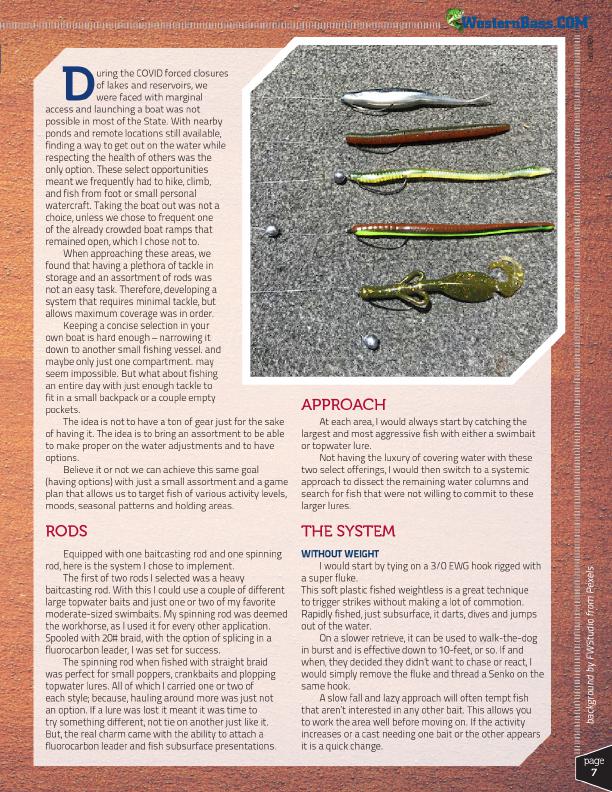
®
Fall 2020
D
uring the COVID forced closures
of lakes and reservoirs, we
were faced with marginal access and launching a boat was not
possible in most of the State. With nearby
ponds and remote locations still available,
finding a way to get out on the water while
respecting the health of others was the
only option. These select opportunities
meant we frequently had to hike, climb,
and fish from foot or small personal
watercraft. Taking the boat out was not a
choice, unless we chose to frequent one
of the already crowded boat ramps that
remained open, which I chose not to.
When approaching these areas, we
found that having a plethora of tackle in
storage and an assortment of rods was
not an easy task. Therefore, developing a
system that requires minimal tackle, but
allows maximum coverage was in order.
Keeping a concise selection in your
own boat is hard enough – narrowing it
down to another small fishing vessel. and
maybe only just one compartment. may
seem impossible. But what about fishing
an entire day with just enough tackle to
fit in a small backpack or a couple empty
pockets.
The idea is not to have a ton of gear just for the sake
of having it. The idea is to bring an assortment to be able
to make proper on the water adjustments and to have
options.
Believe it or not we can achieve this same goal
(having options) with just a small assortment and a game
plan that allows us to target fish of various activity levels,
moods, seasonal patterns and holding areas.
APPROACH
At each area, I would always start by catching the largest and most aggressive fish with either a swimbait or topwater lure.
Not having the luxury of covering water with these two select offerings, I would then switch to a systemic approach to dissect the remaining water columns and search for fish that were not willing to commit to these larger lures.
RODS
Equipped with one baitcasting rod and one spinning rod, here is the system I chose to implement.
The first of two rods I selected was a heavy baitcasting rod. With this I could use a couple of different large topwater baits and just one or two of my favorite moderate-sized swimbaits. My spinning rod was deemed the workhorse, as I used it for every other application. Spooled with 20# braid, with the option of splicing in a fluorocarbon leader, I was set for success.
The spinning rod when fished with straight braid was perfect for small poppers, crankbaits and plopping topwater lures. All of which I carried one or two of each style; because, hauling around more was just not an option. If a lure was lost it meant it was time to try something different, not tie on another just like it. But, the real charm came with the ability to attach a fluorocarbon leader and fish subsurface presentations.
THE SYSTEM
WITHOUT WEIGHT
I would start by tying on a 3/0 EWG hook rigged with a super fluke. This soft plastic fished weightless is a great technique to trigger strikes without making a lot of commotion. Rapidly fished, just subsurface, it darts, dives and jumps out of the water.
On a slower retrieve, it can be used to walk-the-dog in burst and is effective down to 10-feet, or so. If and when, they decided they didn’t want to chase or react, I would simply remove the fluke and thread a Senko on the same hook.
A slow fall and lazy approach will often tempt fish that aren’t interested in any other bait. This allows you to work the area well before moving on. If the activity increases or a cast needing one bait or the other appears it is a quick change.
background by FWStudio from Pexels
page
7